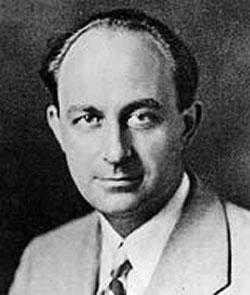Enrico Fermi, born September 29, 1901 in Rome, died November 29, 1954 in Chicago, an Italian physicist. He holds the 1938 Nobel Prize for Physics.
His father is police chief Alberto Fermidir. He first enrolled in grammar school. Satisfied his father's friends, A. Amidei, who discovers and supports his first mathematical and physical abilities.
In 1918 he won the scholarship of the University of Pisa. After 4 years at the University of Pisa, he received his doctorate from Professor Puccianti in 1922.
A year later in 1923 he won a scholarship from the Italian government. And he worked with professor Max Born in Göttingen for a few months. Rockefeller went to Leyden in 1924 to work with Paul Ehrenfest. In the same year he went to Italy to give mathematical physics classes at the University of Florence.
In 1926, Fermi discovered the statistics of the fragments of Pauli, now known as the Fermi statistic. Contrary to the Bose-Einstein statistically-based spoilers, these fragments are known as fermions. In 1927 Fermi became a professor of theoretical physics at the University of Rome. He continued this mission until he escaped Mussolini's fascist dictatorship in 1938 and emigrated to America (shortly after receiving the Nobel Prize).
In his early years in Rome, he gave himself to solve electromagnetic problems and to explain theoretically some spectroscopic phenomena. But he realized the real progress of his work on electrons and atomic nuclei. In 1934 he developed the Beta Bozon Theory and merged it with Pauli's theory of radiation. After discovering Curie and Joliot's artificial radiation, they discovered that nearly every element trapped in the neutron bombardment is subject to nuclear conversion. This research has led to the discovery of slow neutrons and nuclear fusion, as well as the discovery of elements that were different from the periodic table-known elements.
In 1938, Fermi was undoubtedly the best on neutrons. He continued his work in America. Immediately after arriving in the United States, he was appointed professor of physics at Columbia University. After the discovery of fusion by Hahn and Strassmann in early 1939, he calculated the probability of spontaneous and chained reactions of secondary neutrons. He continued his work with great enthusiasm and performed the first chain reaction under control after many experiments. He then played an important role in overcoming the problems of atom bomb construction, one of the leaders of the Manhattan Project.

In 1944, Fermi became an American citizen. II. After World War II, he accepted a professorship from the University of Chicago for his nuclear work, which lasted until his death in 1954. Here he gave density to high energy physics and pioneered the study of pion-nucleon interaction. Fermi spent the last years of her life researching the source of cosmic rays. He eventually developed a theory that shows cosmic rays are enormous energy sources.
This set of neutrons was built at the University of Chicago's campus to contain uranium combined with graphite blocks that slowed down at thermal rates. Cadmium rods were placed in the atomic pile to absorb the neutrons and thus control the rate of reaction. The cadmium rods were pulled slowly and a self-sustained chain reaction was observed. Fermin's success has been the beginning of the first nuclear reactor in the world and the beginning of the atomic age. Fermi died of cancer at the age of 53. A year later, the hundredth element was discovered, and for his honor this element was named fermium.
The Nobel Prize was awarded to him for his work in the field of radiation and nuclear energy created by slow neutrons. Fermi was married in 1928 with Laura Capon. There is a daughter named Giulio, a son named Nella. He liked to walk in the free time, climb and winter sports. He died in Chicago on November 29, 1954.
releases
Fermi has many publications on theoretical and experimental physics. Some of these are the "Sulla quantizzazione del gas perfetto monoatomico", Rend., Which accounts for the statistic of electronic gases and the gases of Paul's particles. Accad. Affectation. Lincei, 1935, Quantelheorie und Chemie, Leipzig, 1928, Über die magnetischen Momente der Atomkerne, Z. Phys., 1930, Tentativo di, which examines the atomic statistical model (Thomas-Fermi atom model) and a new semiquantitative method for the calculation of atomic properties una teoria dei raggi ß, Ricerca Scientifica, 1933.
This post has received a 0.88 % upvote from @drotto thanks to: @hasancantaskiran.
Downvoting a post can decrease pending rewards and make it less visible. Common reasons:
Submit
This post has received a 0.28 % upvote from @morwhale thanks to: @hasancantaskiran.
Downvoting a post can decrease pending rewards and make it less visible. Common reasons:
Submit
This post has received a 0.62 % upvote from @speedvoter thanks to: @hasancantaskiran.
Downvoting a post can decrease pending rewards and make it less visible. Common reasons:
Submit